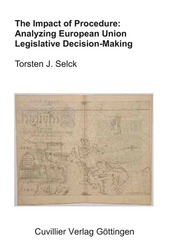| Areas | |
|---|---|
| Serie de libros (96) |
1377
|
| Nachhaltigkeit |
3
|
| Gesundheitswesen |
1
|
| Letra |
2362
|
| Medienwissenschaften | 16 |
| Teología | 57 |
| Filosofía | 102 |
| Derecho | 422 |
| Economía | 850 |
| Ciencias sociales | 416 |
| Ciencias del deporte | 48 |
| Psicología | 233 |
| Educación | 190 |
| Historia | 182 |
| Arte | 110 |
| Ciencias culturales | 165 |
| Literatur | 116 |
| Lingüística | 88 |
| Ciencias Naturales |
5405
|
| Ciencias Ingeniería |
1789
|
| General |
97
|
|
Leitlinien Unfallchirurgie
5. Auflage bestellen |
|
Erweiterte Suche
The Impact of Procedure: Analyzing European Union Legislative Decision-Making (Tienda española)
Torsten Jörg Selck (Autor)Previo
Indice, Datei (78 KB)
Lectura de prueba, Datei (150 KB)
This book presents an attempt to empirically test the explanatory power of procedural models which were designed for European Union legislative decision-making. After outlining the research questions and presenting different existing models which have been put forward to enhance our understanding of how the EU works and how legislation is being negotiated by the political actors within this organization, I first introduced the European policy process by comparing it to the legislative process in the United States. I then compared the different procedural models in terms of the assumptions which they make regarding the sequence of play, actors’ decision weight, and the dimensionality of the policy space. Computer simulation techniques were employed to evaluate the effect changes of different model parameters, such as the number of players, the decision rule, and the dimensionality of decision making. The objective of this chapter was to assess how stable the models are against changes that affect parameters other than agenda-setting and amendment power.
| ISBN-10 (Impresion) | 3865371728 |
| ISBN-13 (Impresion) | 9783865371720 |
| ISBN-13 (E-Book) | 9783736911727 |
| Idioma | Inglés |
| Numero de paginas | 114 |
| Edicion | 1 Aufl. |
| Volumen | 0 |
| Lugar de publicacion | Göttingen |
| Lugar de la disertacion | Leiden |
| Fecha de publicacion | 20.09.2004 |
| Clasificacion simple | Tesis doctoral |
| Area |
Ciencias sociales
|








